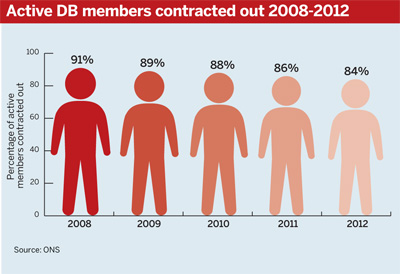Data analysis: Data show more than four-fifths of active defined benefit members remain contracted out, as consultants have said the costs associated with ending the arrangement have bolstered the hunt for alternatives.
The data released this week by the Office for National Statistics show 84 per cent of active DB members are still contracted out. The figures cover the period 2008-2012 and show a continued fall from 91 per cent in 2008.
But as employers shift towards defined contribution arrangements, the removal of contracting-out for DB has spurred some employers to explore alternatives to help dampen the financial impact on their balance sheets.
Key points
84% of active members in private sector DB schemes are contracted out
Contracting-out for DB will be removed in 2016, adding costs to employers and members
The government is due to report back on its defined ambition consultation, and CDC is one option some view as a viable and cost-effective alternative for employers currently operating DB schemes
Contracting-out allows members to forgo the additional state pension and instead receive a top-up from their employer, which in turn receives a national insurance rebate. However, the introduction of the single-tier state pension means the ability to contract out is set to end in 2016.
“[Employers] may decide [single-tier] is the straw that broke the camel’s back,” said Nicola Rondel, of counsel at law firm Hogan Lovells, adding that the “fundamental change in legislation gives employers the option to approach employees about closing the scheme”.
Many are looking to alternatives such as collective defined contribution as a viable replacement for DB.
The government is expected to report back in the next few weeks following a consultation on defined ambition pensions – and CDC is one of the options tabled.
A 2013 study, ‘Collective Pensions in the UK’, by research organisation RSA in conjunction with consultancy Aon Hewitt, determined that a CDC pension would have achieved a 33 per cent better outcome than an individual pension over the past 58 years, and would have provided less variable returns.
“I’m hoping that the Department for Work and Pensions will introduce [CDC] in time to give employers another option,” said James Patten, principal consultant at Aon Hewitt.
“[The government] needs to put a viable alternative out there fast enough for employers to have a choice,” said Mike Smedley, partner at consultancy KPMG. “They are cutting it fine.”

Statutory override
The Pensions Bill 2013/14 contains a provision for a statutory override, enabling employers to sidestep scheme rules in order to reduce benefits or increase contributions as a way of recouping the loss of the rebate.
However, the override potentially raises a number of problems as it is not applicable to protected pensions such as former public sector schemes, said Patten.
“It will not be possible to amend benefits for protected pensions in that way,” he said. “Employers will have to find other ways to deal with [the increased cost].”
Trustee boards are typically receptive to the difficulties of running a DB scheme, he added, potentially rendering powers to bypass them unnecessary.














